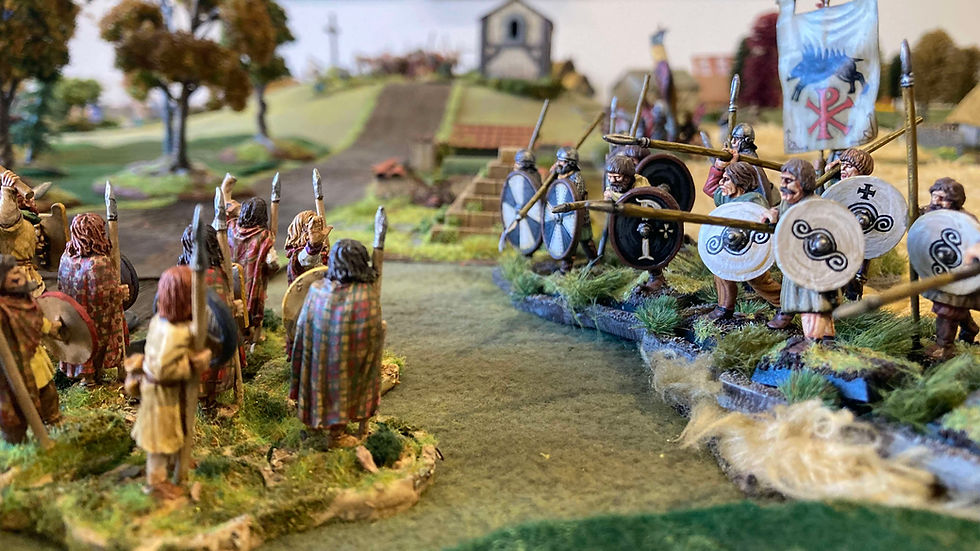Both sides win and lose
- Simon MacDowall
- Apr 5, 2023
- 3 min read
Last weekend I put on an Alala! game at the 19th Society of Ancients Battle Day featuring 2nd Mantinea (362 BC). As ever, the day was good fun with great camaraderie. The rules are available as a free download here. They are going to be published in print by the Society of Ancients.

Our game used 20 mm figures — mostly Pete O’Toole’s wonderful 1:72 scale plastic hoplites supplemented by Newline Designs’ metals. The orders of battle and deployment followed Duncan Head (see slingshot #343). The Theban heavily weighted left flank was deployed behind a cavalry/skirmisher screen. The Mantineans were formed up in the gap between steep hills and had to recover their order after having stood down when the thought the Thebans were not going to attack.

The idea behind Alala! is to get your Hoplite phalanxes ordered and psychologically ready before signalling the advance to close with the enemy. Appropriate sacrifices to the gods (drawing from a pack of cards) may well provide divine support. Once the phalanxes begin to move in on each other there is little scope for tactical finesse or complex manoeuvre. Light troops and cavalry play a subordinate role — harassing and annoying the enemy and driving off enemy skirmishers.

The Thebans had more cavalry and skirmishers, especially on their left. They pushed these forward to drive off the Mantinean/Spartan skirmishers and to clear the position for the advance of the formidable Theban phalanx. It did not go so well for the Thebans on the other wing. Here, after a lot of to-ing and fro-ing, the Athenian cavalry and skirmishers, supported by the Elian reserve took the position, threatening the Theban right.

Encouraged by the success of his cavalry the Athenian general, commanding the Mantinean left, signalled the advance. The Athenian hoplites surged forward with great élan and forced back the Argives facing them.

On the other wing the Mantinean hoplites had begun to take casualties from the Theban skirmishers. In a surprise move they withdrew in face of the advance by the deep Theban phalanx.

This was a cunning plan to draw the Thebans in while the Spartans wheeled forward hoping to take them in the flank. This move was countered by the Tegan phalanx which was also deeply deployed.

When the Tegan and Spartan hoplites clashed the initial result was inconclusive and othismos continued until the deeper Tegan formation began to gain an advantage and the supporting Spartan flanking unit was engaged by the Theban Euboian allies.

The Mantinean hoplites turned to face as the Theban phalanx bore down on them. Worn down by the enemy skirmishers, and having lost aggression from their earlier withdrawal, the Maniteans had no chance of standing up to the Theban juggernaut.

The Athenians were the clear winners. They had driven off the Argives and were in a position to roll up the centre. The Mantineans and Spartans were the clear losers, their phalanxes decimated and thrown back by the Thebans and Tegans. That the Athenians, Spartans and Mantineans were all on the same side gave the sort of outcome where both sides might well erect trophies to their victory and seek truce to collect their dead as if defeated — much like the historical outcome in 362 BC.
The rules worked well, with only a couple of situations that needed a bit of clarification. Above all the game was great fun and it felt like what we might image a hoplite battle could have been.



Great AAR and stunning armies!
Great write-up. Fantastic!
good game and lovely figures.
Super looking game and a great report of the action. I wish I could have been there to see it and join in with the 'debrief' in the evening. I look forward to playing it later in the month :-)
It was a cracking game, Simon, and an excellent weekend - despite the appalling journeys most of us had to get there!
Great report and some splendid photos - they remind me of the pictures of Tony Bath's wargames using flats that were in one of Donald Featherstone's books. Inspiring!